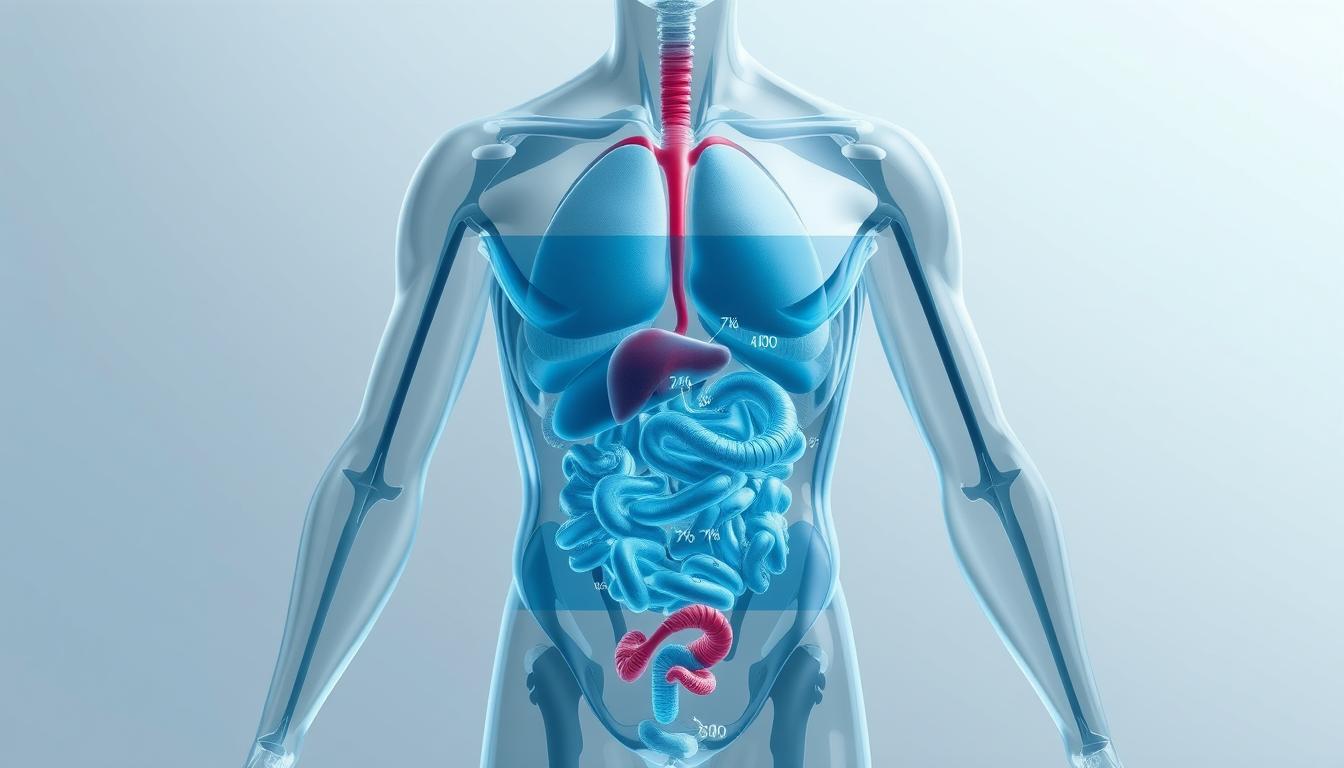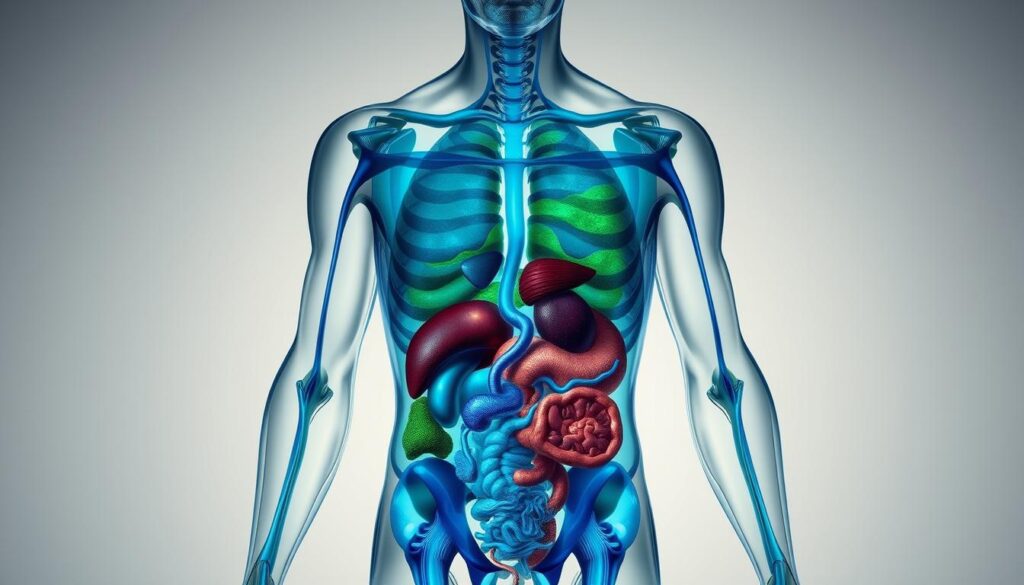“The human body is 60% water, give or take a few percent.” This quote highlights the significance of water in our bodily composition. Our body water percentage calculator is designed to estimate the volume of water in your body based on age, height, weight, and sex, using a formula developed by Dr. P.E. Watson and his team.
Water makes up a significant portion of the human body and plays a crucial role in various bodily functions. Factors such as age, sex, weight, and height affect your body water percentage. Understanding this metric is essential for overall health and wellness.
Our calculator provides an accurate estimation based on scientific formulas, helping you understand your body’s composition and maintain healthy water levels.
Key Takeaways
- Understand the importance of body water percentage for overall health.
- Learn how our calculator estimates body water volume using the Watson formula.
- Discover how factors like age, sex, weight, and height affect your body water percentage.
- Find out why monitoring body water percentage is crucial for maintaining healthy bodily functions.
- Get insights into maintaining optimal body water levels.
What Body Water Percentage Means
Understanding body water percentage is crucial for maintaining overall health. It reflects the proportion of our body weight that is made up of water.
Definition and Importance
Body water percentage is defined as the proportion of total body weight that is water. Maintaining proper body water levels is vital for numerous bodily functions, including temperature regulation, nutrient transport, and waste removal. It’s a more comprehensive measurement than simple hydration, reflecting overall body water content.
Factors Affecting Body Water Content
Several factors influence body water content, including age, sex, body composition, and activity level. For instance, muscle tissue contains more water than fat tissue, which is why athletes typically have higher body water percentages. The normal range for total body water volume is 58 ± 8% for males and 48 ± 6% for females.
| Sex | Normal Total Body Water Percentage Range |
|---|---|
| Male | 50% – 66% |
| Female | 42% – 54% |
The Science Behind Body Water Percentage Calculator
The scientific foundation of our body water percentage calculator lies in Dr. P.E. Watson’s formula, developed through extensive research. This formula calculates total body water (TBW) in liters for adults of any age.
Watson’s Formula Explained
Dr. P.E. Watson’s formula is based on comprehensive research that accounts for various factors influencing total body water. For males, TBW (l) = 2.447 − 0.09156 × age (years) + 0.1074 × height (cm) + 0.3362 × weight (kg). For females, TBW (l) = -2.097 + 0.1069 × height (cm) + 0.2466 × weight (kg). These equations highlight the importance of multiple factors in determining body water percentage.
Why Height, Weight, Age, and Sex Matter
Height, weight, age, and sex are crucial in calculating body water percentage. Height correlates with overall body volume, while weight influences total body water due to its relation to muscle mass. Age affects body composition, leading to natural decreases in body water percentage over time. Sex is also a significant factor due to differences in muscle mass and body fat distribution between males and females.
| Factor | Influence on Body Water Percentage |
|---|---|
| Height | Correlates with overall body volume and potential water storage capacity |
| Weight | Influences total body water due to its relation to muscle mass |
| Age | Affects body composition, leading to natural decreases in body water percentage |
| Sex | Differences in muscle mass and body fat distribution between males and females |
How to Use Our Body Water Percentage Calculator
Using our body water percentage calculator is straightforward and requires just a few simple measurements. To get accurate results, it’s essential to understand what information is needed and how to input it correctly.
Required Measurements
To calculate your body water percentage, you’ll need to provide your height, weight, age, and sex. Ensure that your measurements are accurate and in the correct units.
Here’s a simple table to help you understand the required measurements:
| Measurement | Unit | Importance |
|---|---|---|
| Height | inches or cm | Affects body water percentage calculation |
| Weight | lbs or kg | Directly related to body water percentage |
| Age | years | Influences body water percentage due to changes in body composition |
| Sex | Male/Female | Affects body water percentage due to differences in body composition |
Step-by-Step Calculation Process
Enter your water weight and body weight into the Calculator. The calculator will evaluate the Body Water Percentage. You can enter any 2 values to calculate the missing variable.
Tips for Accurate Results
For the most accurate results, measure your weight at the same time of day and under similar conditions. Avoid calculating your body water percentage after intense exercise or in extreme temperatures.
By following these simple steps and tips, you can ensure that your body water percentage calculation is accurate and reliable.
Understanding Your Results
Once you’ve calculated your body water percentage, it’s essential to understand what the results mean. Your body water percentage is a critical indicator of your overall health, reflecting the amount of water in your body relative to your weight.
Normal Ranges for Adults
For adults, the normal range for body water percentage varies between males and females due to differences in body composition.
Male Body Water Percentages
On average, males have a body water percentage of around 60%, with an acceptable range of 58 ± 8%. This means that for males, a healthy body water percentage typically falls between 50% and 66%.
Female Body Water Percentages
Females, on average, have a lower body water percentage, around 50%, with an acceptable range of 48 ± 6%. Thus, for females, a healthy range is generally between 42% and 54%.
Body Water Compartments Explained
Body water is distributed into different compartments. The majority, about 2/3, is intracellular fluid, which is the fluid within cells. The remaining 1/3 is extracellular fluid, found outside cells.
Extracellular fluid is further divided into:
- Plasma (1/5 of extracellular fluid), which is part of the blood volume.
- Interstitial fluid (4/5 of extracellular fluid), surrounding cells.
- Transcellular fluid, a smaller component often ignored in calculations, includes fluids like gastrointestinal, cerebrospinal, and ocular fluids.
Tips for Maintaining Healthy Body Water Levels
Proper hydration is key to maintaining healthy body water levels and overall health. To achieve this, drink a decent amount of water throughout the day. Eating plenty of fresh fruits and vegetables also contributes to your daily water intake.
We recommend calculating your daily water needs based on your weight, activity level, and environmental conditions. Regular exercise can positively impact your body composition and water percentage over time. However, it also increases the need for hydration during physical activity.
To track your hydration status, monitor your urine color, check for skin elasticity, and use our body water percentage calculator periodically. By following these tips, you can maintain optimal body water levels and overall health.


